JEEP GRAND CHEROKEE 2015 WK2 / 4.G Owners Manual
Manufacturer: JEEP, Model Year: 2015, Model line: GRAND CHEROKEE, Model: JEEP GRAND CHEROKEE 2015 WK2 / 4.GPages: 717, PDF Size: 18.54 MB
Page 491 of 717
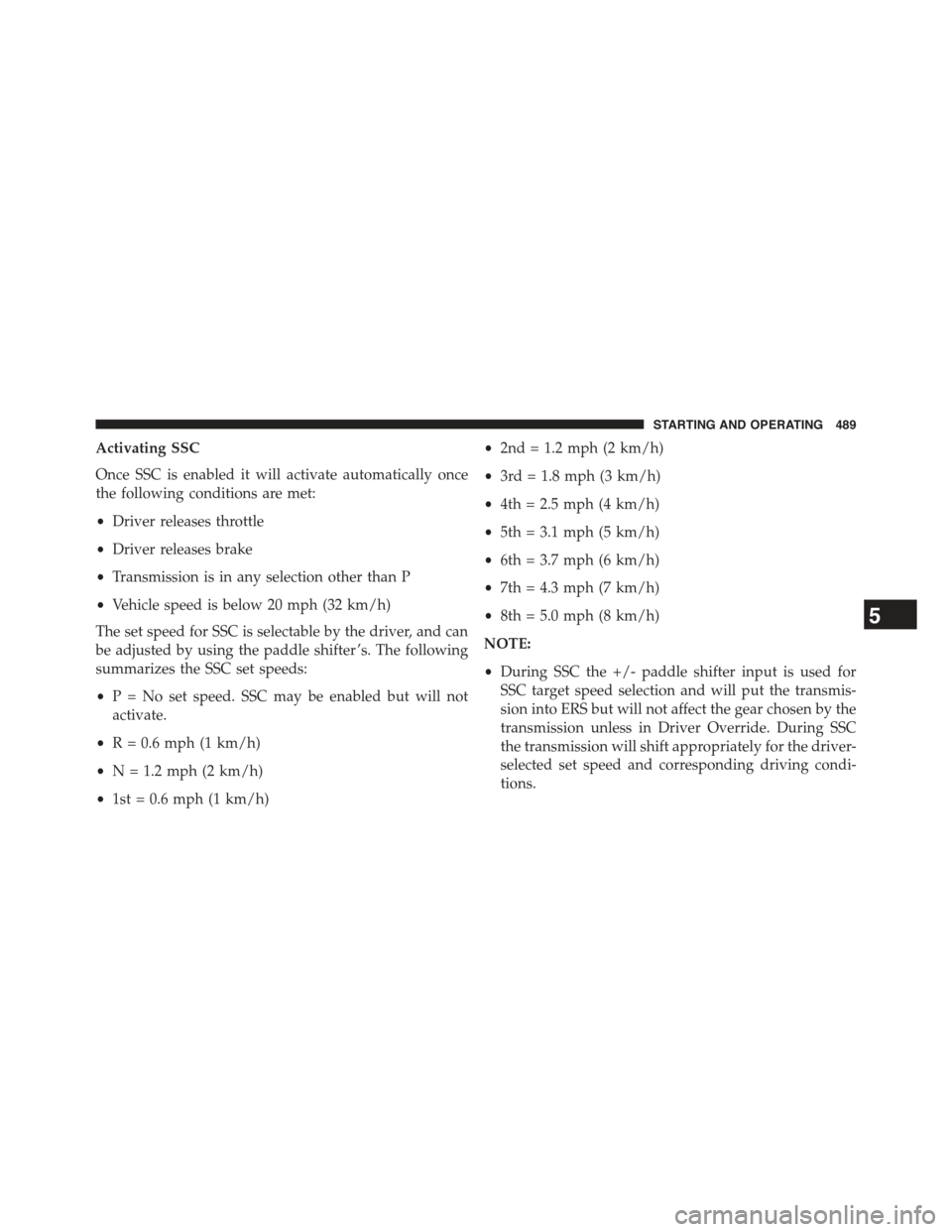
Activating SSC
Once SSC is enabled it will activate automatically once
the following conditions are met:
ŌĆóDriver releases throttle
ŌĆóDriver releases brake
ŌĆóTransmission is in any selection other than P
ŌĆóVehicle speed is below 20 mph (32 km/h)
The set speed for SSC is selectable by the driver, and can
be adjusted by using the paddle shifter ŌĆÖs. The following
summarizes the SSC set speeds:
ŌĆóP = No set speed. SSC may be enabled but will not
activate.
ŌĆóR = 0.6 mph (1 km/h)
ŌĆóN = 1.2 mph (2 km/h)
ŌĆó1st = 0.6 mph (1 km/h)
ŌĆó2nd = 1.2 mph (2 km/h)
ŌĆó3rd = 1.8 mph (3 km/h)
ŌĆó4th = 2.5 mph (4 km/h)
ŌĆó5th = 3.1 mph (5 km/h)
ŌĆó6th = 3.7 mph (6 km/h)
ŌĆó7th = 4.3 mph (7 km/h)
ŌĆó8th = 5.0 mph (8 km/h)
NOTE:
ŌĆóDuring SSC the +/- paddle shifter input is used for
SSC target speed selection and will put the transmis-
sion into ERS but will not affect the gear chosen by the
transmission unless in Driver Override. During SSC
the transmission will shift appropriately for the driver-
selected set speed and corresponding driving condi-
tions.
5
STARTING AND OPERATING 489
Page 492 of 717
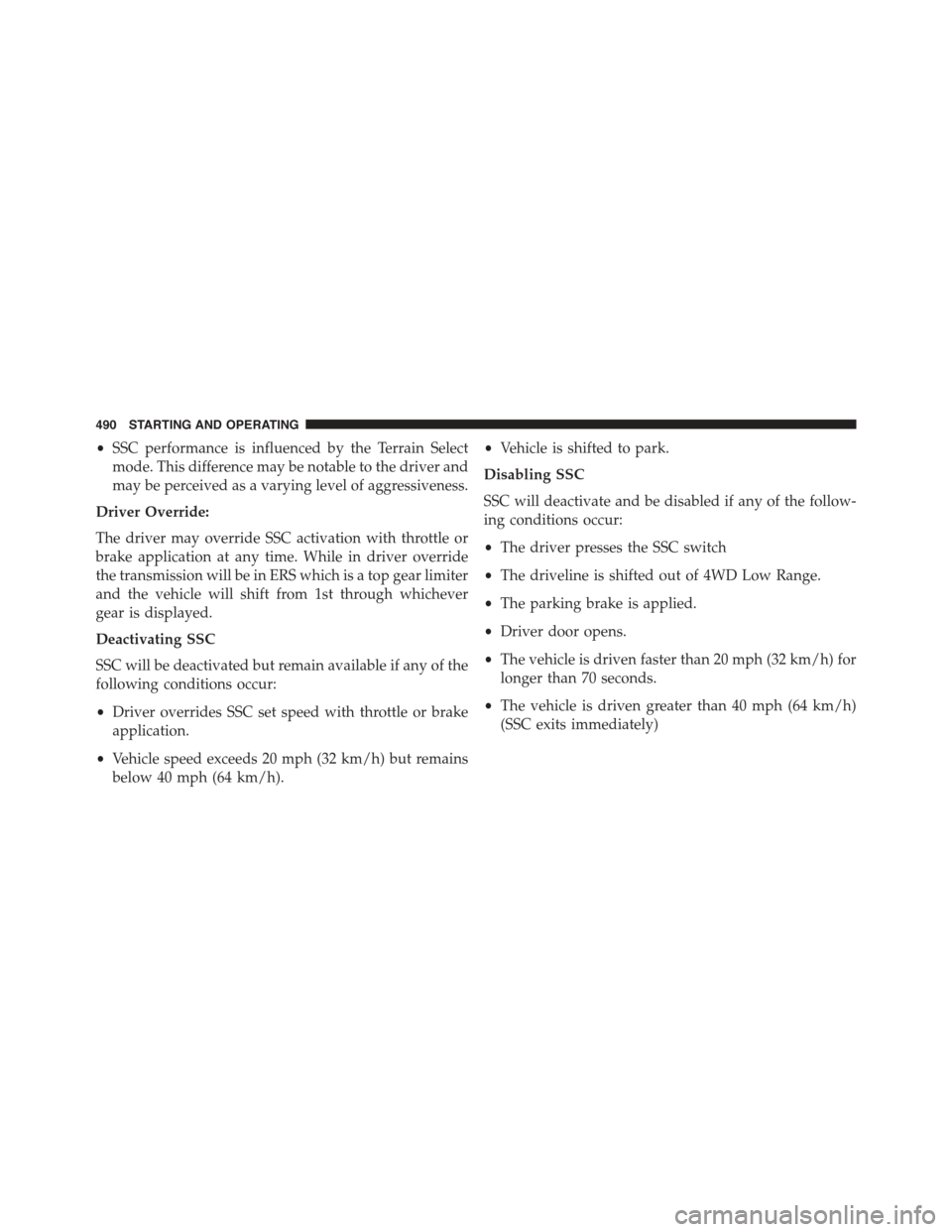
ŌĆóSSC performance is influenced by the Terrain Select
mode. This difference may be notable to the driver and
may be perceived as a varying level of aggressiveness.
Driver Override:
The driver may override SSC activation with throttle or
brake application at any time. While in driver override
the transmission will be in ERS which is a top gear limiter
and the vehicle will shift from 1st through whichever
gear is displayed.
Deactivating SSC
SSC will be deactivated but remain available if any of the
following conditions occur:
ŌĆóDriver overrides SSC set speed with throttle or brake
application.
ŌĆóVehicle speed exceeds 20 mph (32 km/h) but remains
below 40 mph (64 km/h).
ŌĆóVehicle is shifted to park.
Disabling SSC
SSC will deactivate and be disabled if any of the follow-
ing conditions occur:
ŌĆóThe driver presses the SSC switch
ŌĆóThe driveline is shifted out of 4WD Low Range.
ŌĆóThe parking brake is applied.
ŌĆóDriver door opens.
ŌĆóThe vehicle is driven faster than 20 mph (32 km/h) for
longer than 70 seconds.
ŌĆóThe vehicle is driven greater than 40 mph (64 km/h)
(SSC exits immediately)
490 STARTING AND OPERATING
Page 493 of 717
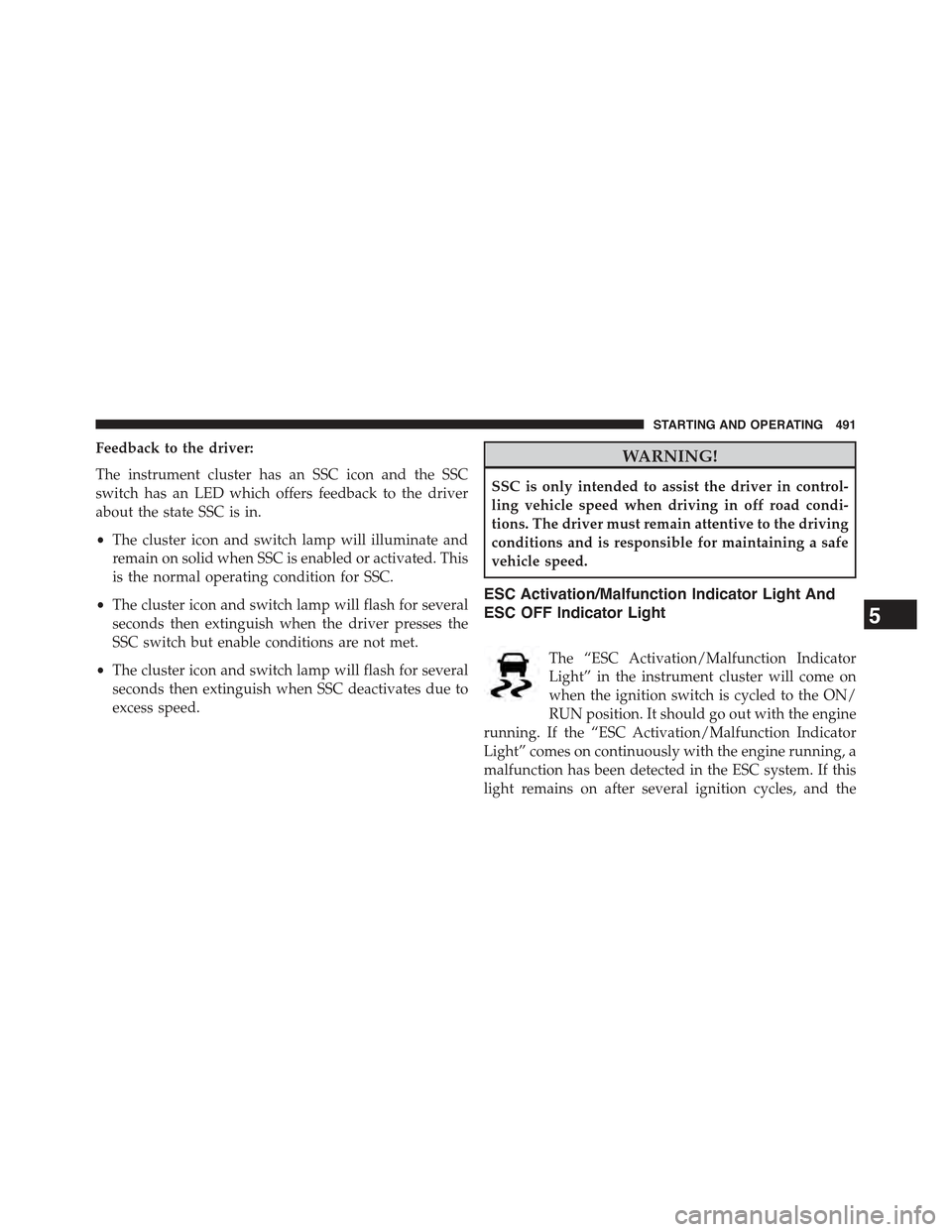
Feedback to the driver:
The instrument cluster has an SSC icon and the SSC
switch has an LED which offers feedback to the driver
about the state SSC is in.
ŌĆóThe cluster icon and switch lamp will illuminate and
remain on solid when SSC is enabled or activated. This
is the normal operating condition for SSC.
ŌĆóThe cluster icon and switch lamp will flash for several
seconds then extinguish when the driver presses the
SSC switch but enable conditions are not met.
ŌĆóThe cluster icon and switch lamp will flash for several
seconds then extinguish when SSC deactivates due to
excess speed.
WARNING!
SSC is only intended to assist the driver in control-
ling vehicle speed when driving in off road condi-
tions. The driver must remain attentive to the driving
conditions and is responsible for maintaining a safe
vehicle speed.
ESC Activation/Malfunction Indicator Light And
ESC OFF Indicator Light
The ŌĆ£ESC Activation/Malfunction Indicator
LightŌĆØ in the instrument cluster will come on
when the ignition switch is cycled to the ON/
RUN position. It should go out with the engine
running. If the ŌĆ£ESC Activation/Malfunction Indicator
LightŌĆØ comes on continuously with the engine running, a
malfunction has been detected in the ESC system. If this
light remains on after several ignition cycles, and the
5
STARTING AND OPERATING 491
Page 494 of 717
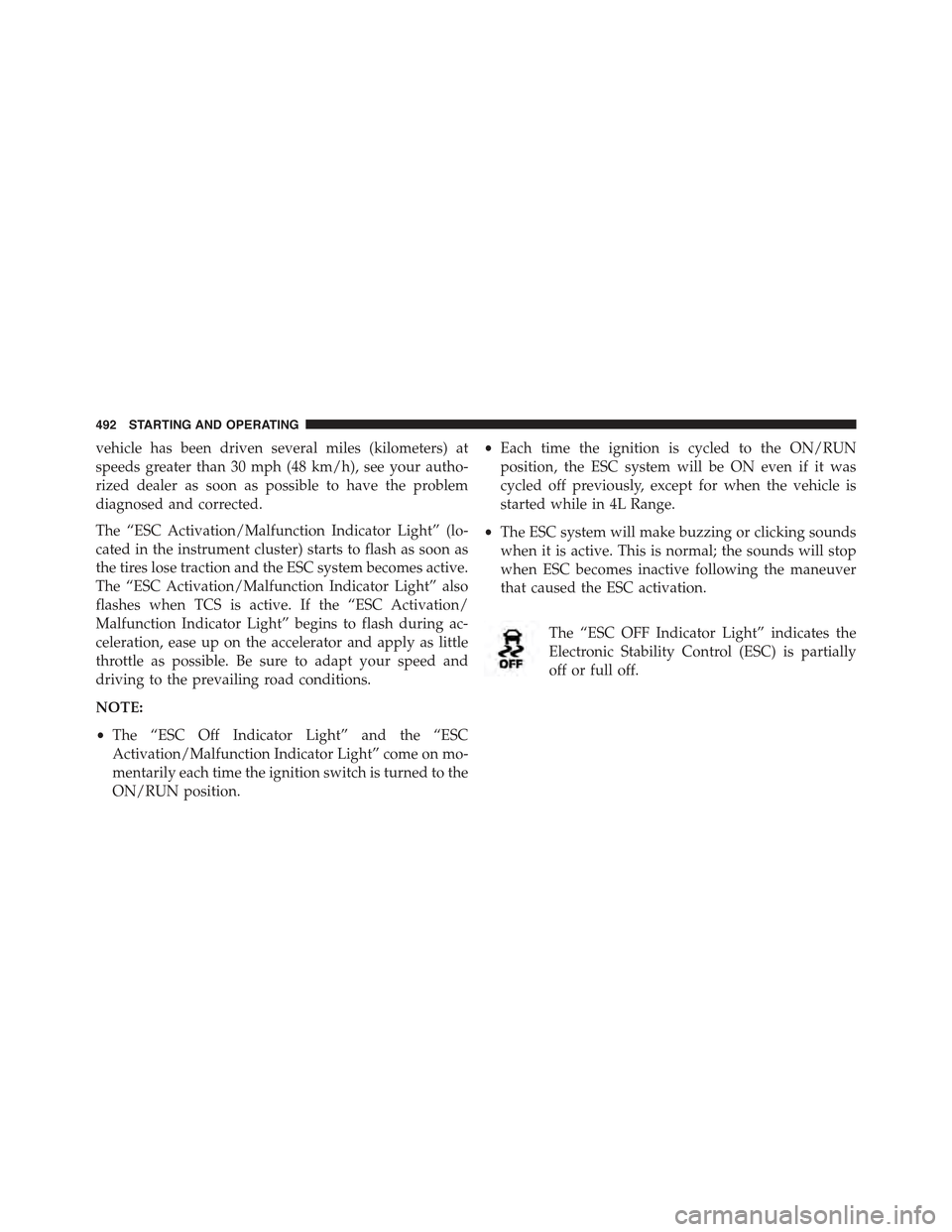
vehicle has been driven several miles (kilometers) at
speeds greater than 30 mph (48 km/h), see your autho-
rized dealer as soon as possible to have the problem
diagnosed and corrected.
The ŌĆ£ESC Activation/Malfunction Indicator LightŌĆØ (lo-
cated in the instrument cluster) starts to flash as soon as
the tires lose traction and the ESC system becomes active.
The ŌĆ£ESC Activation/Malfunction Indicator LightŌĆØ also
flashes when TCS is active. If the ŌĆ£ESC Activation/
Malfunction Indicator LightŌĆØ begins to flash during ac-
celeration, ease up on the accelerator and apply as little
throttle as possible. Be sure to adapt your speed and
driving to the prevailing road conditions.
NOTE:
ŌĆóThe ŌĆ£ESC Off Indicator LightŌĆØ and the ŌĆ£ESC
Activation/Malfunction Indicator LightŌĆØ come on mo-
mentarily each time the ignition switch is turned to the
ON/RUN position.
ŌĆóEach time the ignition is cycled to the ON/RUN
position, the ESC system will be ON even if it was
cycled off previously, except for when the vehicle is
started while in 4L Range.
ŌĆóThe ESC system will make buzzing or clicking sounds
when it is active. This is normal; the sounds will stop
when ESC becomes inactive following the maneuver
that caused the ESC activation.
The ŌĆ£ESC OFF Indicator LightŌĆØ indicates the
Electronic Stability Control (ESC) is partially
off or full off.
492 STARTING AND OPERATING
Page 495 of 717
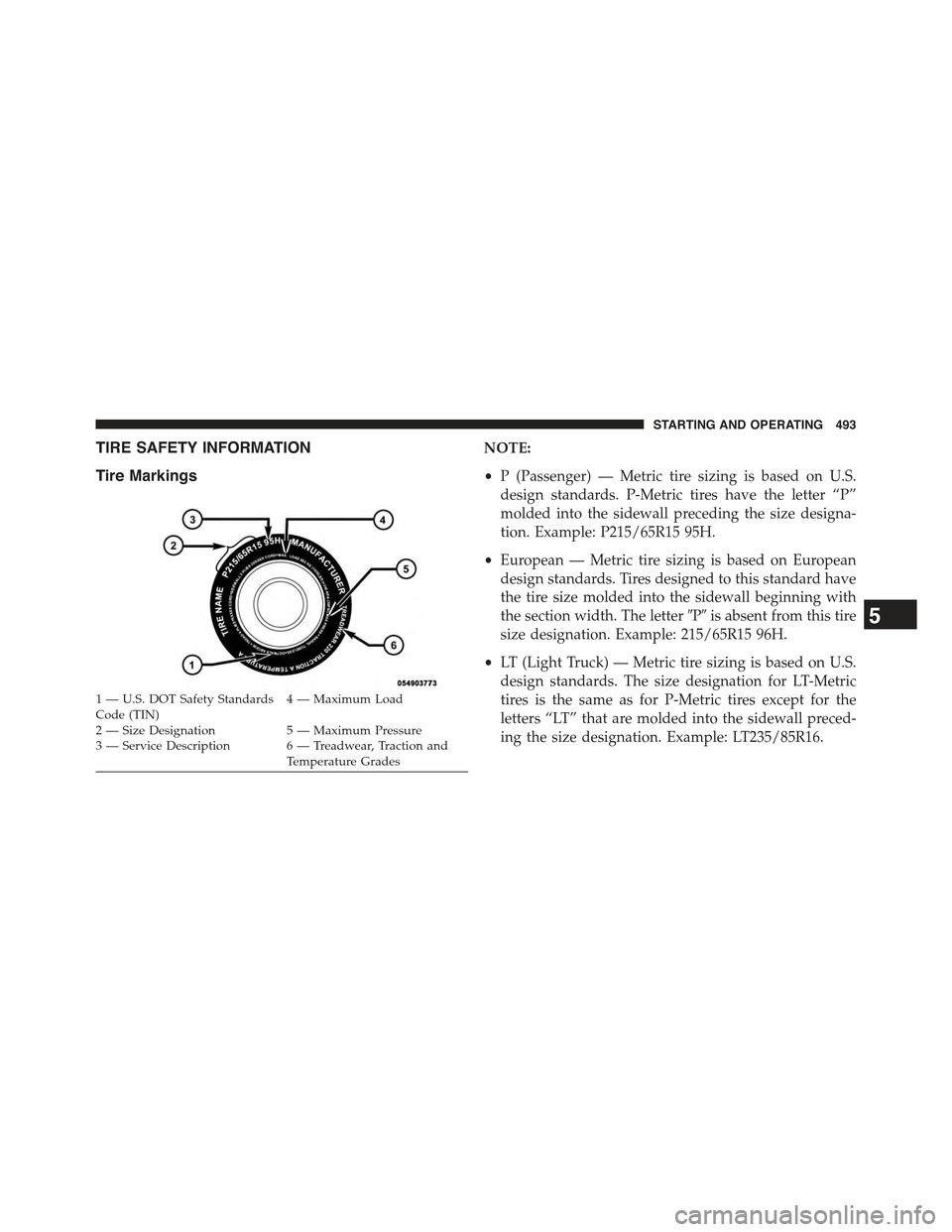
TIRE SAFETY INFORMATION
Tire Markings
NOTE:
ŌĆóP (Passenger) ŌĆö Metric tire sizing is based on U.S.
design standards. P-Metric tires have the letter ŌĆ£PŌĆØ
molded into the sidewall preceding the size designa-
tion. Example: P215/65R15 95H.
ŌĆóEuropean ŌĆö Metric tire sizing is based on European
design standards. Tires designed to this standard have
the tire size molded into the sidewall beginning with
the section width. The letter#P#is absent from this tire
size designation. Example: 215/65R15 96H.
ŌĆóLT (Light Truck) ŌĆö Metric tire sizing is based on U.S.
design standards. The size designation for LT-Metric
tires is the same as for P-Metric tires except for the
letters ŌĆ£LTŌĆØ that are molded into the sidewall preced-
ing the size designation. Example: LT235/85R16.
1ŌĆöU.S.DOTSafetyStandardsCode (TIN)4ŌĆöMaximumLoad
2ŌĆöSizeDesignation 5ŌĆöMaximumPressure3 ŌĆö Service Description 6 ŌĆö Treadwear, Traction andTemperature Grades
5
STARTING AND OPERATING 493
Page 496 of 717
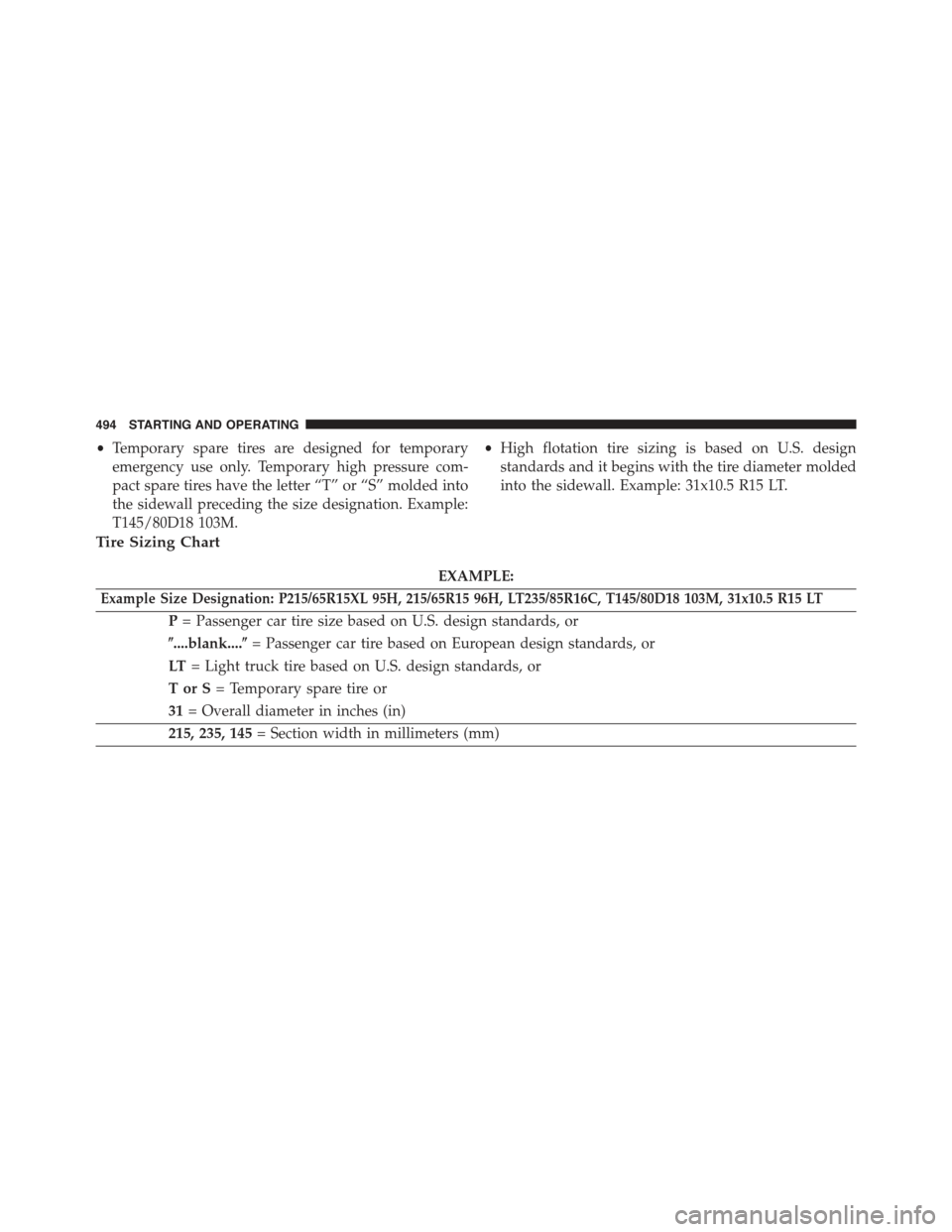
ŌĆóTemporary spare tires are designed for temporary
emergency use only. Temporary high pressure com-
pact spare tires have the letter ŌĆ£TŌĆØ or ŌĆ£SŌĆØ molded into
the sidewall preceding the size designation. Example:
T145/80D18 103M.
ŌĆóHigh flotation tire sizing is based on U.S. design
standards and it begins with the tire diameter molded
into the sidewall. Example: 31x10.5 R15 LT.
Tire Sizing Chart
EXAMPLE:
Example Size Designation: P215/65R15XL 95H, 215/65R15 96H, LT235/85R16C, T145/80D18 103M, 31x10.5 R15 LT
P= Passenger car tire size based on U.S. design standards, or
'....blank....'= Passenger car tire based on European design standards, or
LT= Light truck tire based on U.S. design standards, or
TorS= Temporary spare tire or
31= Overall diameter in inches (in)
215, 235, 145= Section width in millimeters (mm)
494 STARTING AND OPERATING
Page 497 of 717
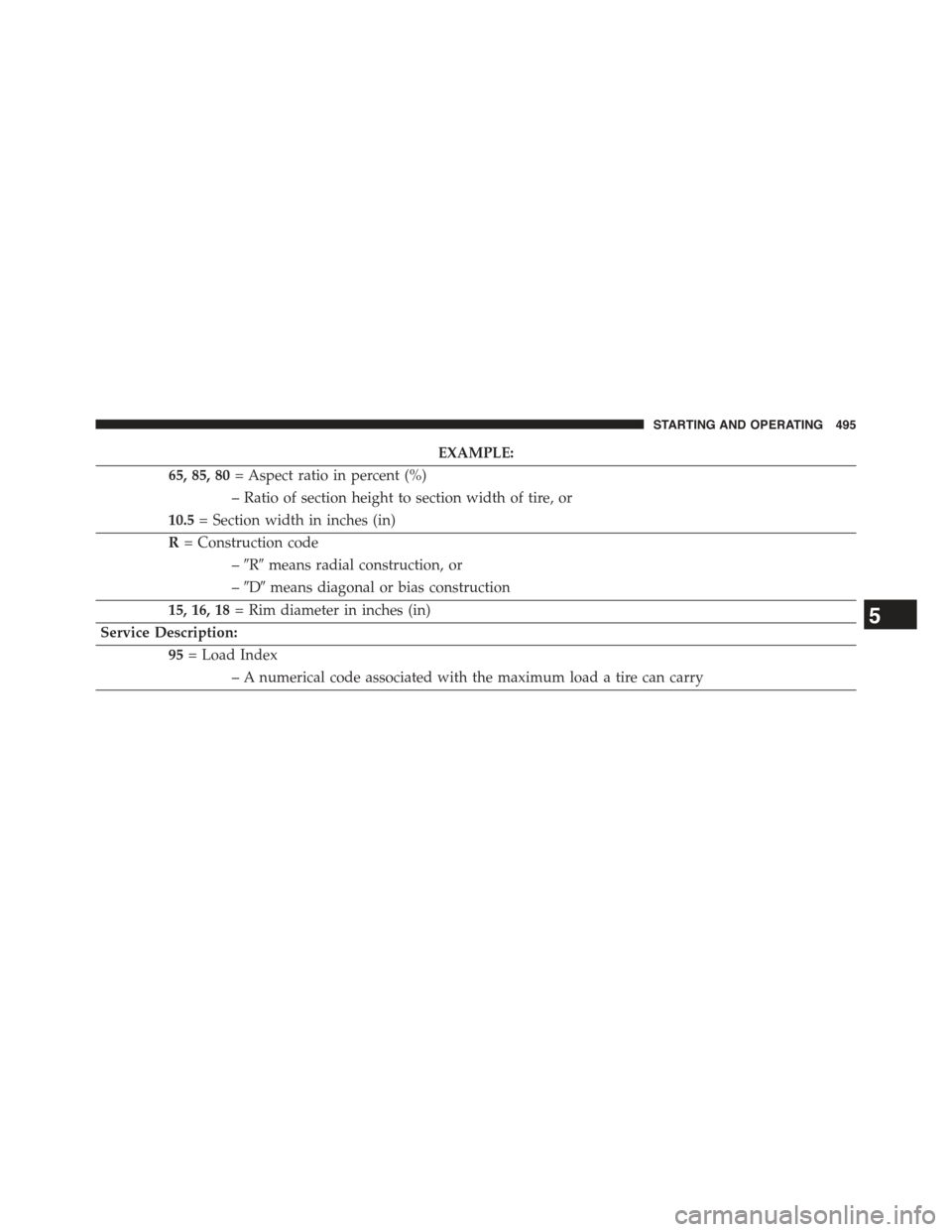
EXAMPLE:
65, 85, 80= Aspect ratio in percent (%)
ŌĆō Ratio of section height to section width of tire, or
10.5= Section width in inches (in)
R= Construction code
ŌĆō#R#means radial construction, or
ŌĆō#D#means diagonal or bias construction
15, 16, 18= Rim diameter in inches (in)
Service Description:
95= Load Index
ŌĆō A numerical code associated with the maximum load a tire can carry
5
STARTING AND OPERATING 495
Page 498 of 717
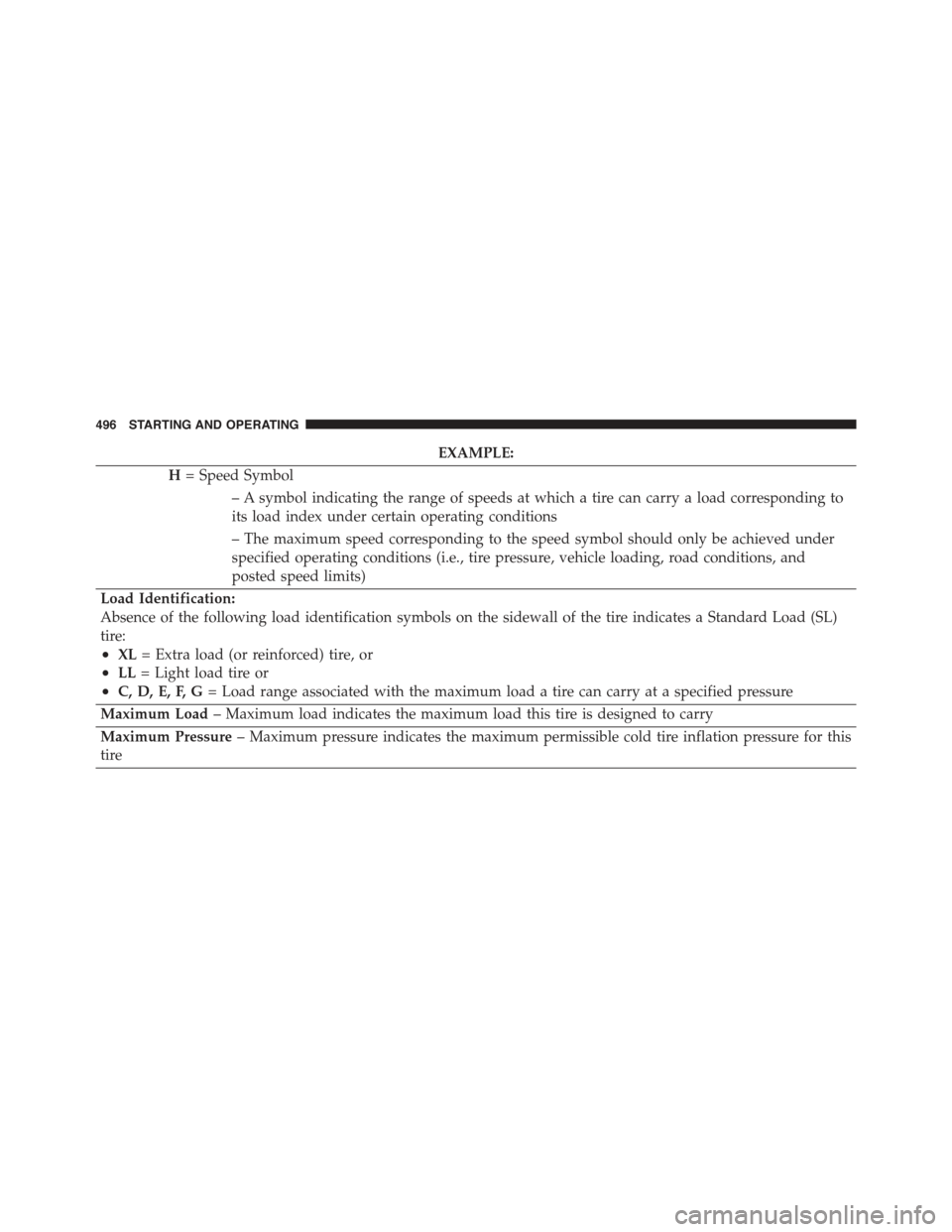
EXAMPLE:
H= Speed Symbol
ŌĆō A symbol indicating the range of speeds at which a tire can carry a load corresponding to
its load index under certain operating conditions
ŌĆō The maximum speed corresponding to the speed symbol should only be achieved under
specified operating conditions (i.e., tire pressure, vehicle loading, road conditions, and
posted speed limits)
Load Identification:
Absence of the following load identification symbols on the sidewall of the tire indicates a Standard Load (SL)
tire:
ŌĆóXL= Extra load (or reinforced) tire, or
ŌĆóLL= Light load tire or
ŌĆóC, D, E, F, G= Load range associated with the maximum load a tire can carry at a specified pressure
Maximum LoadŌĆō Maximum load indicates the maximum load this tire is designed to carry
Maximum PressureŌĆō Maximum pressure indicates the maximum permissible cold tire inflation pressure for this
tire
496 STARTING AND OPERATING
Page 499 of 717
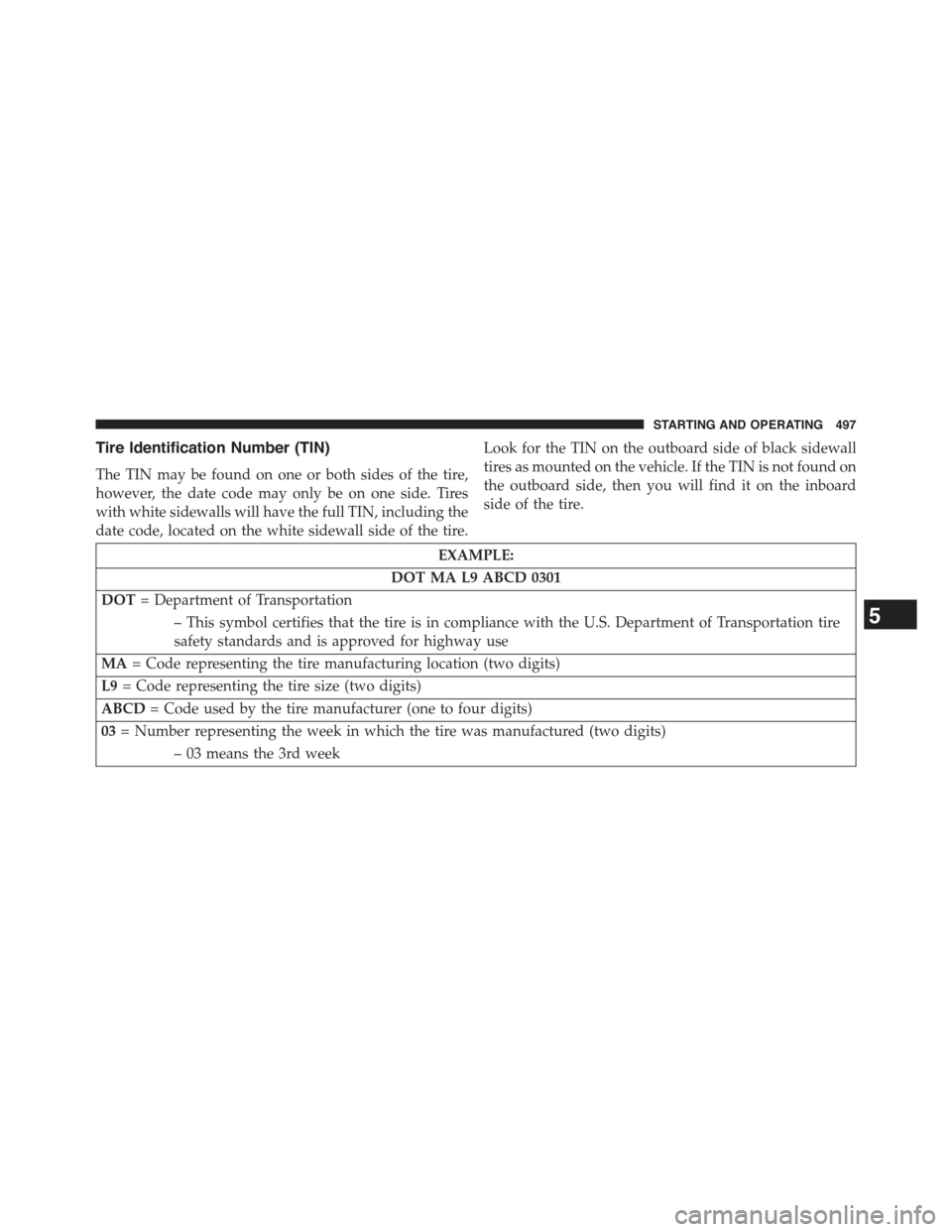
Tire Identification Number (TIN)
The TIN may be found on one or both sides of the tire,
however, the date code may only be on one side. Tires
with white sidewalls will have the full TIN, including the
date code, located on the white sidewall side of the tire.
Look for the TIN on the outboard side of black sidewall
tires as mounted on the vehicle. If the TIN is not found on
the outboard side, then you will find it on the inboard
side of the tire.
EXAMPLE:
DOT MA L9 ABCD 0301
DOT= Department of Transportation
ŌĆō This symbol certifies that the tire is in compliance with the U.S. Department of Transportation tire
safety standards and is approved for highway use
MA= Code representing the tire manufacturing location (two digits)
L9= Code representing the tire size (two digits)
ABCD= Code used by the tire manufacturer (one to four digits)
03= Number representing the week in which the tire was manufactured (two digits)
ŌĆō 03 means the 3rd week
5
STARTING AND OPERATING 497
Page 500 of 717
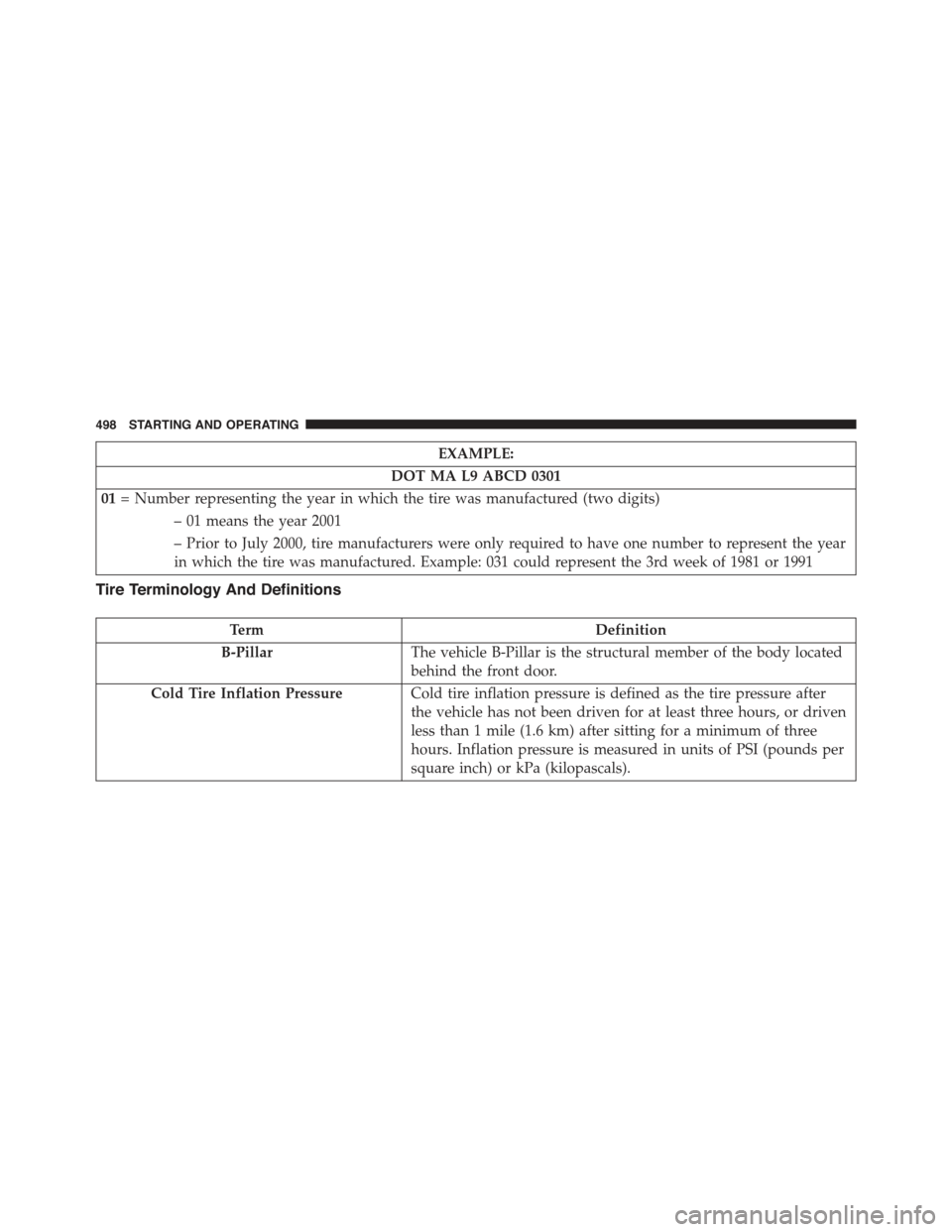
EXAMPLE:
DOT MA L9 ABCD 0301
01= Number representing the year in which the tire was manufactured (two digits)
ŌĆō 01 means the year 2001
ŌĆō Prior to July 2000, tire manufacturers were only required to have one number to represent the year
in which the tire was manufactured. Example: 031 could represent the 3rd week of 1981 or 1991
Tire Terminology And Definitions
TermDefinition
B-PillarThe vehicle B-Pillar is the structural member of the body located
behind the front door.
Cold Tire Inflation PressureCold tire inflation pressure is defined as the tire pressure after
the vehicle has not been driven for at least three hours, or driven
less than 1 mile (1.6 km) after sitting for a minimum of three
hours. Inflation pressure is measured in units of PSI (pounds per
square inch) or kPa (kilopascals).
498 STARTING AND OPERATING